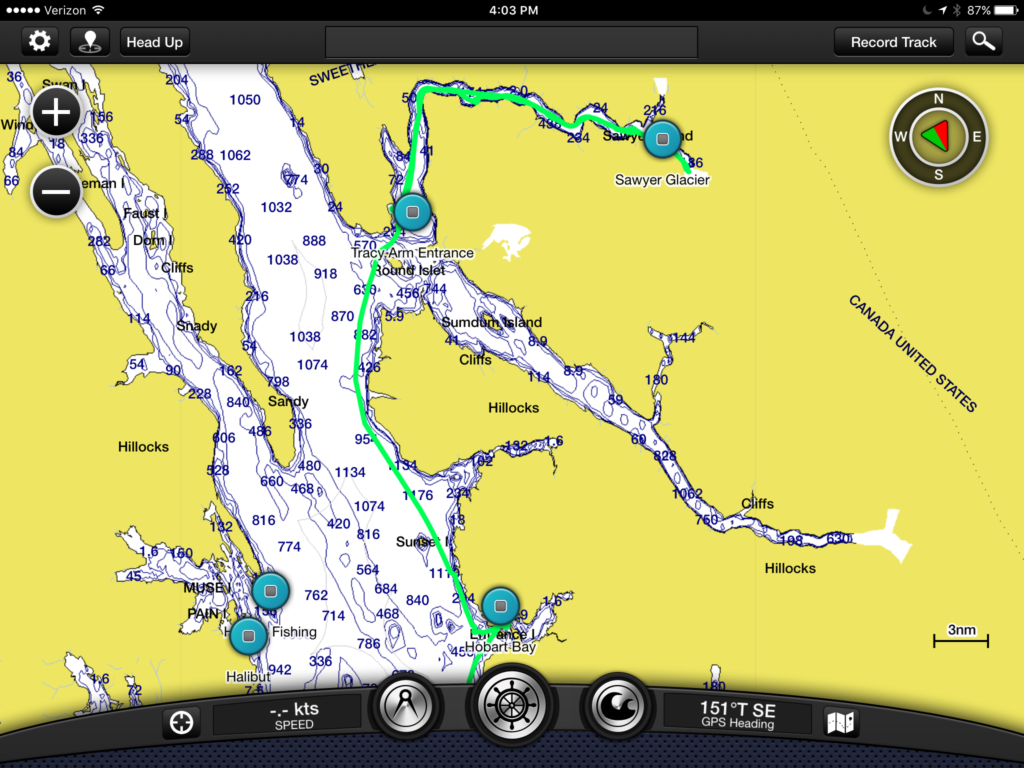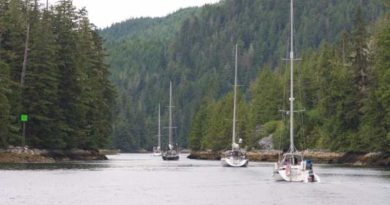The Hunted Becomes The Hunter In Hobart Bay
(August 1st, 2017)
With the glacier conquered, it was time to turn south for the first time in six weeks. We pulled up our anchors in Tracy Arm Anchorage, and carefully picked our way through the entrance bar, into Holkham Bay.

The sensation of going south was disorienting at first. The chart plotter always seemed to be pointing in the wrong direction, and the sun appeared to run backward. It took about 48 hours to adjust to the change in direction. During our passage from Tracy Arm to Hobart, the instances of icebergs quickly diminished to zero; which was good, because it was a dark and rainy day, and visibility was low.

The entire fleet was coming off the high of cruising in literal uncharted water, and the banality of a rainy motor south, with only disappointing fishing to speak of, left us empty, and unstimulated. I watched dully as the water turned from a milky, glacial green to clear and then suddenly brown-red. Radio chatter during that first run south was sporadic at best. That is, until Sea Pie, in the lead, approached the anchorage.
“Sail Alaska, Sail Alaska, Sail Alaska, this is Sea Pie. We’ve just reached the outer harbor at Hobart Bay, and we’re being blocked from proceeding to the inner harbor by a pod of orcas.”
I did a double-take – orcas? All we’d seen for weeks were humpback whales, surely that’s what Sea Pie meant? I wasn’t the only one wondering, and another member of our fleet responded: “Sea Pie, repeat. Did you say orcas? Not humpbacks?”
“Affirmative, we are watching a pod of orcas here. It’s spectacular.”
For our part, we’d given up fishing early after we hooked three salmon, two of which got away as soon as we got them to the boat. One out of three was not good enough odds to go to the effort of reeling them in, so we cut our losses and pulled up with the front of the fleet. Only Sea Pie, in the lead, and Glendora, preceded us.
Sea Pie and Glendora enjoyed a 20-minute orca show before our arrival. We approached the anchorage carefully, first navigating the maze of rocks into the outer harbor, and then turning into the inner harbor. We hung back before entering, not wanting to disturb the orcas. We saw a dorsal fin in the harbor, and carefully moved forward through the inner entrance. Moments later, several dorsal fins appeared directly in front of us, just for a moment, and then disappeared back into the passage. The pod was headed out, and saw fit to bid us their adieus before leaving the bay.
The sight of orcas, however brief, was familiar and comforting, reminding us of our home waters in the Salish Sea. We anchored contently, and no sooner had we settled in that the wildlife show began anew: Just off Glendora’s bow, and about 300 feet in front of us, two large animals were in a battle to the death at the surface of the water. They splashed wildly between moments of underwater combat, slashing, thrashing, biting, tearing. The slightly larger animal slapped the smaller one against the surface of the water, battering it and beating it and killing it, over and over again. At first, the fleet guessed that it was a sea lion eating a sea otter, but it was soon confirmed that a sea lion had caught a very large halibut, feasting on its flesh even as the fish fought for its life. After 10 minutes, the halibut was dismantled, and the satisfied sea lion disappeared below the surface. We were left to wonder if the sea lion knew how close it had come to being the meal just an hour before, when the orcas were hunting in that same bay.
As the evening approached, an unusual thing happened; the clouds separated, revealing a golden sun. Except for some rare peeks at Sawyer Glacier, it was the first we’d seen of it in days, and its presence required that we spend our evening outside. Despite some bug activity, I rigged up a pole and decided to jig for a halibut to rival the sea lion’s. A humpback meandered into the cove, and likely finding that the orca had already snagged the best fish, wandered back out. After catching two sculpins, I gave up fishing and headed in for the evening.
I woke up in the middle of the night that night. Looking up, I saw something we hadn’t seen once so far in Alaska – tiny pinpricks of light filled the sky. Some of the stars were obscured by the moon, which shone warmly on one end of the bay. I wanted to stay awake and stargaze, but my fear of bugs and calm sleepiness won out after just a few minutes.
The next morning we woke up to an unusual light radiating on us; above, the sky was clear, and the sun shone warm and bright. We’d been teased with the sun for a few hours at a time over the past few days, but a completely clear day was only vaguely familiar. Our entire family was tired from the excitement of the past few days, but the sun would give us enough energy to make some hay while the sun shined.
First, we fired up the watermaker. We’d noticed when we entered Hobart Bay that the brown-red water we saw outside the bay pervaded the bay itself, but for some reason it didn’t occur to us not to run the watermaker. Our fishing guide had explained in some of the other bays that the water color was due to recent logging activity in the area (“recent” being within the last 10 or so years), resulting from tannins washed off the decaying refuse into the water. It hadn’t occurred to us that it might be a bad idea to run the watermaker in such water, so we powered it up and filled our aft tank. We realized our mistake days later, when we had to completely empty our tanks and flush the system to get rid of the off, hard-water taste.

In the afternoon, the girls and I kayaked to shore to join a berry-picking shore party. The problem was, there weren’t any berries to be had; the bushes hadn’t yet borne fruit. For some reason, the shore party was looking for berries primarily on the east and north-facing slopes of the island. I proposed that we hunt for berries on the south- and west-facing slopes, which would have had more exposure to the sun to ripen the berries. Despite the group’s general agreement that that was a good idea, the group remained on the darker slopes. I didn’t want to take the girls off wandering into bear country on my own, so we generally stayed with the group, except at the very end when we spotted a south-facing slope not too far away. We picked about 3/4 cup of berries there, and then climbed back across the rocky shore to our kayak, finally paddling back to the boat. Our berry haul was nearly gone by the time we reached Mobert.

We spent the afternoon relaxing in the sunshine, mostly reading and fishing. We watched our first clear sunset in weeks (partially because it was the first time the sunset was early enough for us to stay awake to see it), and headed off to bed. No doubt the sun wouldn’t last, but we were happy to enjoy it while we could. Imagine our surprise when the next morning arrived, just as bright and sunny as the last.




